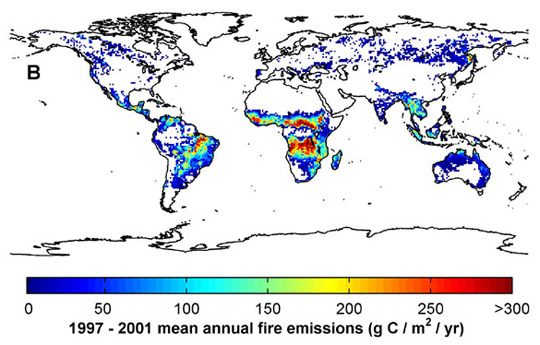Natural Disasters & Environmental Change
Extreme and frequent storms, hurricanes, rainfall, floods, heat waves, droughts, forest fires, avalanches, mudslides and landslides, plus melting glaciers, rising sea levels and ocean temperatures, coral bleaching, El Niño activities and the changing ecosystem all indicate the extent of global environmental change. As a result, climate related disasters are on the rise. About 2.5 billion people were affected by these disasters this past decade compared to 1.7 billion the previous decade. And, scientists are expecting more intense climate hazards throughout the next 20 years, which means sudden, heavy rains, intense storms, repeated flooding and droughts are likely to increase. The most vulnerable areas are those prone to floods, cyclones, storms and droughts and which carry the greatest risk of submerging, i.e., low-lying islands, deltas and coastal areas. The most vulnerable people are those less prepared or less equipped and those with insufficient resources living in poor, overpopulated regions of the world. This article focuses on climate change threats the world is currently facing.
Melting Ice Caps, Glaciers & Permafrost

Credit: German Aerospace Center | This Antarctic rift is the subject of international attention. View an animation of Germany’s TerraSAR-X satellite recording images from Oct. 2011 through Sept. 14, 2012.
The most convincing evidence of climate change can be found in the Arctic. Since the satellite observation of the polar region first began in 1979, September Arctic sea ice extent has declined by 12 percent per decade, according to the National Aeronautics and Space Administration (NASA). Less ice in the summer means a shortened shipping route between the Atlantic and Pacific Oceans. The Northwest Passage, inaccessible until 2009, has opened up, bringing with it more oil drilling, mining, fishing and loss of habitat. Arctic houses and roads are subsiding, and the Arctic countries – Russia, Norway, Canada, United States, Finland, Iceland, Sweden and Denmark – must now address pressing Arctic issues.
The Earth is losing sea ice rapidly with the Arctic losing its sea ice five times faster than the Antarctic. According to NASA, although the Antarctic sea ice is actually growing, scientists are concerned about the continuing glacier retreat in the Antarctic Peninsula and its impact on global sea level rise. This is not a new phenomenon since glaciers around the world have been retreating since 1960. At the top of the list is the Arctic, including Alaska, followed by the high mountainous areas of Asia, Northwest United States, Southwest Canada, Patagonia, Andes and Europe. The calving ice front of the Ilulissat Glacier in Greenland has retreated more than 40 kilometres since 1850, and the glacier surface is thinning by 10 metres each year. Currently, rising temperatures have led to an increasing loss of mass from the ice sheet and a subsequent increase in global sea levels. Permafrost is also melting as temperatures at the top of the permafrost layer have increased up to 3° C (5.4° F) since the 1980s.

Credit: NASA Goddard’s Scientific Visualization Studio | NASA satellite data reveals how 2011’s minimum sea ice extent, reached on Sept. 9, as depicted here, declined to a level far smaller than the 30-year average (in yellow) and opened up Northwest Passage shipping lanes (in red).
If the South Polar Ice Cap melted, sea levels would rise more than 200 feet or 61 metres. If the North Polar Ice Cap melted, sea levels would rise about 20 feet or 6 metres. This would only happen if global temperatures rise 8° to 10° C (14.4° to 18° F), which is currently very unlikely. However, it is possible that temperatures will rise by 1.1° to 6.4° C (1.98° to 11.52° F), but it will probably take hundreds of years to do so, as the average global air temperature for the past 100 years (1906 to 2005) has risen by only 0.74° C (1.33° F). Although current sea level rise is 3.19 mm, many scientists believe average global temperature increases will range from 2° to 4° C (3.6° to 7.2° F) with an additional sea level rise of 1 to 2 metres by the end of this century. Most experts agree that even one metre of sea level rise will displace hundreds of millions of people in low-lying coastal communities. Some parts of the world are already showing effects of warming more than others with the Northern Hemisphere appearing to be warming up faster than the Southern Hemisphere.
Storms, Hurricanes & Thunderstorms
As ocean temperatures rise, warmer seas will result in more frequent and stronger storms, tropical cyclones and hurricanes. According to a recent study published by the National Academy of Sciences, Hurricane Katrina-like magnitude storms are twice as likely in warm years as cold years. In warmer years, the ocean temperature adds energy to storms and the warmer air holds more moisture, thus causing storms to dump more rainfall. So, global warming leads to storms with more energy and more rainfall. Research into the dynamics between climate change and thunderstorm power and frequency suggests that by the end of this century the occurrence of major thunderstorms could rise by more than 100 percent in some places. Moreover, more thunderstorms will be triggered by increasing amounts of humid air generated by global warming. Arctic warming will destabilise jet streams, increasing the risk of extreme weather events. A recent example is Hurricane Sandy, which became a Super Storm after it collided with a cold front from the Arctic.
Earthquakes, Volcanic Eruptions & Tsunamis
Some scientists believe global warming may cause more earthquakes, volcanic eruptions and tsunamis. Although overall evidence is small, a link may exist between these events. Of course, anything that increases or decreases the load on Earth’s crust causes stress and/or strains. In those areas where fault lines already strain the crust, chances are greater for eruptions or slips. Melting ice sheaths, changing sea levels, heavy monsoons and warm weather events can trigger earthquakes, volcanic eruptions or tsunamis as a result of underwater tectonic slides. For instance, melting ice sheaths may be responsible for a considerable amount of pressure to the earth’s surface underneath a glacier. This decreases as the glacier diminishes, thus resulting in a freeing-up of tectonic masses that can lead to earthquake and volcanic activity, which may lead to tsunamis. Therefore, increased volcanic activity, earthquakes, landslides and tsunamis throughout the next century as a result of climate change cannot be ruled out.
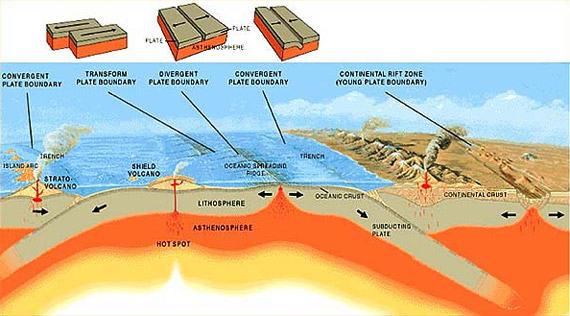
Image courtesy of Submarine Ring of Fire 2002, NOAA/OER | This image shows the many types of plate boundaries: convergent, transform, divergent and continental rift zone. The Explorer Ridge is a divergent plate boundary at an ocean spreading ridge in the eastern Pacific where new oceanic crust is formed.
According to the National Oceanic and Atmospheric Administration (NOAA), “Tectonic processes that influence climate system variability include plate motion, changes in continental geography, mountain building and erosion, production and subduction of seafloor crust and related changes in bio-geo-chemical cycles, particularly the carbon cycle.” These are known as “forcing factors.” Therefore, climate science involves the investigation of climatic and environmental processes.
Floods & More Floods
Universal climate change has already resulted in increased coastal and inland flooding. The four types of floods include: flash floods, coastal floods, river floods and urban floods. Flash floods are the most dangerous and are increasing in intensity and occurrence as are flooding events in general, which have been observed lately all over the world. Heavy rainfall within short time periods, natural variations in weather patterns, global precipitation, increasing high tides, rising sea level, greenhouse gases and the human finger print have all been blamed.
Within the past decade in the United Kingdom, floods have occurred in summer, autumn and winter, which is unusual. After experiencing its wettest summer in 100 years in 2012, the country was blasted by torrential rains, winds and storms through a 10-day period, which caused November floods throughout England, Wales and Scotland – the worst in 30 years.
The monsoon season in India and many other countries in South and Southeast Asia is bringing excessive flooding as well. Abnormal monsoons, heavy monsoons, monsoon failure and strengthened or weekend monsoons have been observed throughout the past 50 years in these countries.
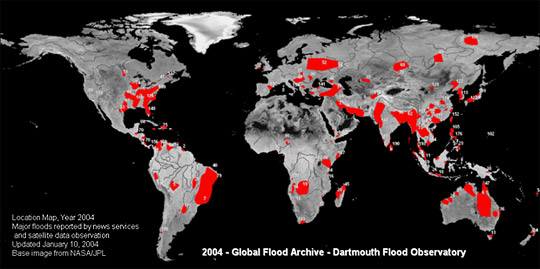
Base Image from NASA/JPL, Courtesy Dartmouth Flood Observatory
Extreme Heat, Heat Waves & Drought
Hot days, hot nights and heat waves are also more frequent. Rising temperatures, extreme heat and an imbalance in the water cycle may be responsible for drought. Less rain and snowfall and increased moisture evaporation from soil resulting from global warming may be leading to an expansion of dry areas as well as increased drought. In addition, land mismanagement, such as overgrazing, increased cultivation and deforestation is, obviously, contributing to adverse impacts with the Sahara Desert the classic example.
In Australia, the drought in 2000 was the worst in a century, thus causing the country’s economic growth to slow. According to experts, 10 percent of Australia’s farm land is unusable as a result of drought, and it was reported that harsh conditions were forcing some farmers to sell their land. Summer 2010 also saw the highest summer temperatures in Russia since recordkeeping began there 130 years ago. The temperature, which reached nearly 7° to 12° C (12° to 22° F) above average and killed 5,000 people, was responsible for the worst drought in more than 100 years.
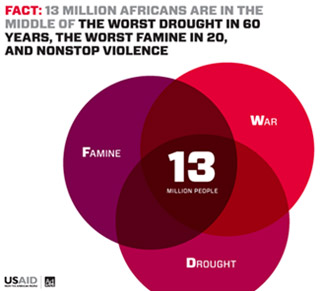
Courtesy USAID
In 2011, Ethiopia, Uganda, Kenya, Somalia and Djibouti experienced their worst reported droughts while in the summer of 2012 America’s corn belt was hit by its worst drought in 50 years. Lack of rainfall and July’s intense heat destroyed the crops.
The world is expected to continue to experience an increased probability and intensity of drought and heat waves in coming years. Drought can increase both prices and inflation, thus sending millions more people into poverty and hunger. As a result, drought still remains one of the major disasters responsible for famine, hunger and starvation in the world, with Africa experiencing the world’s worst devastation.
Bush Fires, Forest Fires & Wildfires
Bush fires, forest fires and wildfires are increasing, and these are more noticeable within countries like Australia, the United States, Russia, Europe, Canada, South and Central America. Effects are more significant in dry areas since drought dries out vegetation, trees, shrubs and grasses, thus making them more vulnerable to spark. Thunderstorms and lightening can naturally ignite wildfires, and as the planet becomes warmer, this effect will become more frequent and more destructive. Fires threaten timber, habitat and human settlements, and it is also responsible for sun shields, which may cause secondary pollution. Forest fire smoke can cause eye irritation, sore throat, cold and cough, chest pain, shortness of breath, wheezing and airway congestion. It can also cause acute worsening of asthma and bronchitis, as well as carbon monoxide poisoning.
Smog, Air Pollution & the Carbon Footprint
Smog is caused by urban air pollution, and sources include: road vehicles like cars, buses and lorries; non-road vehicles like planes, trains and ships; industries; businesses and households. Pollutants are mostly sulphur, nitrogen oxide, carbon monoxide and ozone. Smog is harmful to health, and most big cities face this hazard. According to the World Health Organization (WHO), one in five of the world’s population is exposed to unhealthy levels of sulphur dioxide. And, the Third World is its major victim. It is predicted that smog-related deaths will rise by about 4.5 percent from the 1990s to 2050s. And a 2010 early study in rats funded by the U.S. Environmental Protection Agency (EPA) and Texas A&M Health Science Center provides the first direct indication that a component of smog might trigger cell death in the heart.
Since its creation, Earth’s atmosphere has been in constant change. Initially gradual and slow, this change has become rapid since the industrial revolution. Prior to the latter, most change was due to natural effects – primarily those of volcanic eruptions where large quantities of dust, ash and gas were ejected into the atmosphere – while other factors included continental drifts, tectonic shifts and comet impacts.
However, the current area of great concern is global warming resulting from human activities, which adds to the natural greenhouse effect. Carbon footprint, or carbon profile, consists of the overall amount of carbon dioxide (Co2) and other greenhouse gas (GHG) emissions (methane, nitrogen oxide, etc.) associated with a product along with its supply chain. These emissions are mostly from fossil fuel use, transport operations and other industrial and agriculture products. According to International Energy Statistics, the top 10 countries by carbon dioxide emissions are: 1.) China, 2.) United States, 3.) India, 4.) Russia, 5.) Japan, 6.) Germany, 7.) Canada, 8.) South Korea, 9.) Iran and 10.) United Kingdom.

Courtesy NASA | Data from NASA’s Aqua satellite show concentrations in the atmosphere of CO2, a gas known to influence climate change. ASCENDS, a proposed mission, would provide continuous global-scale measurments of CO2.
Cold Waves & the Arctic
A cold wave is defined as a rapid fall of temperature throughout a 24-hour period. Cold waves are formed by large, cool air masses that accumulate over certain areas and are caused by movements of air stream. They can kill people and animals, destroy crops and effect transportation and power systems, as well as other essential infrastructure. Cold wave phenomena are increasing, and from 2009 to 2010 reports of winter storms increased across the Northern Hemisphere. Arctic winds and snows gripped China and moved across Russia to Western Europe over to the United States and Canada. This represented the United Kingdom’s coldest winter after the great freeze in 1963. In the future, more frequent cold waves may occur due to global warming. The logical explanation is the Arctic is becoming warmer, which pushes Arctic air towards the Northern Hemisphere, thus acting to refrigerate the region in winter time.
Wildlife, Ocean Life, Animal Attacks & Animal Extinction
Loss of polar ice means loss of certain habitat in the Arctic and Antarctica with the most vulnerable species being the polar bear, arctic fox, adelie and emperor penguins. Declines in reproduction and increases in mortality rate among seabirds, seals and sea lions have been observed and documented as a result of rising oceanic temperature. In addition, ocean acidification, reduction of phytoplankton and warmer surface temperatures have been identified in the decrease of other aquatic life, such as snails, crustaceans, molluscs and coral reefs.
Animals driven from their natural habitat or normal migration routes by environmental factors could easily come into contact with human settlements, thus leading to many deaths among humans and already endangered species. Attacks on humans and their livestock have been reported from tigers in India and lions in Kenya’s Amboseli National Park. Similarly, sharks are moving into new areas to find a more stable food supply, which means fewer are living within the waters of California and Florida now. The world’s forests are also disappearing with the resultant loss of species that live there.
Diminished Water & Food Supply
About 97.5 percent of the Earth’s water is salt water, and the remaining 2.5 percent is fresh water. Demand for water is mainly for agricultural, industrial and domestic use. Millions of people do not have access to clean drinking water, and the demand for water will increase as the world population grows. Lack of rain, over-extraction of water, drought, loss of soil fertility, rising sea levels and salinity resulting from climate change will create more problems regarding access to water and food supplies. This will increase food prices, famine, diseases, malnutrition, starvation and death. The most affected areas will be Africa and Asia.
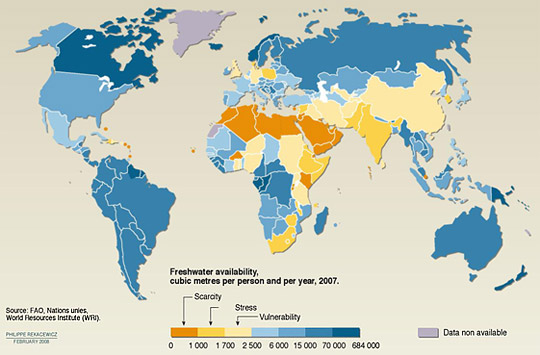
Source: FAO, United Nations and World Resources Institute
Health & Spread of Disease
Global climate change will also have major effects on public health, which are already occurring. Some serious illnesses are also exacerbated by effects of pollution. Many people will suffer from coughs, breathing issues, chest pain, respiratory tract infections, eye diseases, rhino sinusitis and lung diseases. People with hay fever, asthma and chronic obstructive lung diseases will get worse. Stomach-related gastrointestinal diseases and parasitic diseases will increase. Certain types of cancers will increase, such as skin and lung cancer. Many experts anticipate an effect on immunity, which will activate infections. The reintroduction and increased spread of malaria will occur in certain areas, as well as tick-borne diseases like Lyme disease, West Nile virus, dengue fever, avian flue, cholera, plague, Ebola and tuberculosis. Extreme heat and cold cause fatal illnesses, and chronic food and water insecurity have an indirect, adverse impact on health.
Migration, Conflicts & War
Environmental or climate refugees will become a common occurrence as global warming-related environmental disasters, such as drought, famine, desertification, flood, melting ice and sea level rise increase. The term “refugee” is generally used when the migration is considered to be forced and not a matter of individual choice. However, 50 million people are now displaced in any given year by natural disasters, and global climate changes are responsible for a large proportion of these disasters. The world’s many great coastal cities will become flooded and may have to be abandoned. Large populations, who live in coastal regions within many of the poorer and more affluent countries, will be displaced. In addition, certain Pacific and Indian Ocean islands could disappear. Territorial disputes and increased conflicts between countries and ethnic groups may lead to in-fighting, war and environmental migration to regions with less instability.
Conclusion
Global warming is taking place, and it will affect humanity’s future. Most countries have now realised that a more variable climate will exist as the world continues to warm. To solve some of these problems, manmade activities that are elevating global temperatures must be curtailed.










